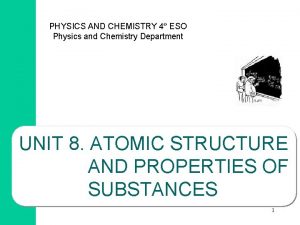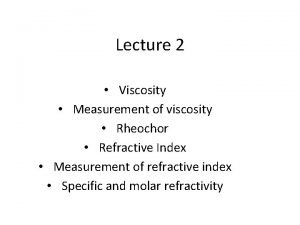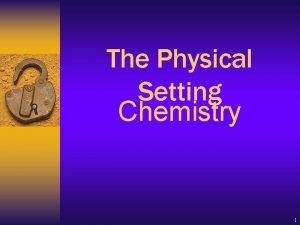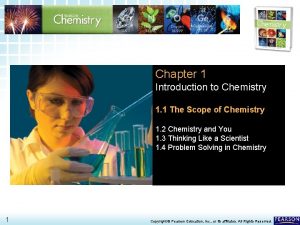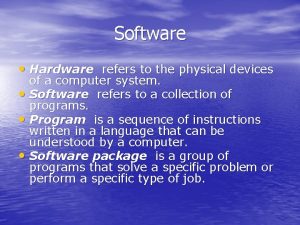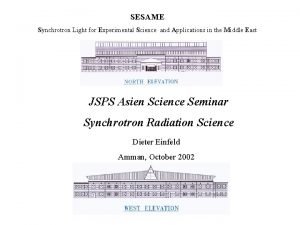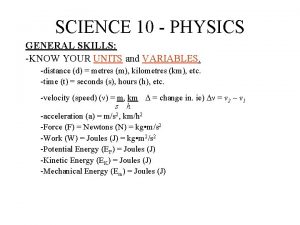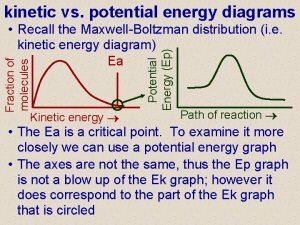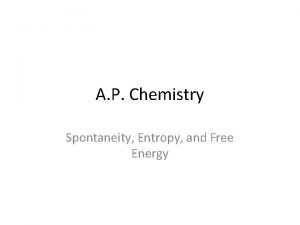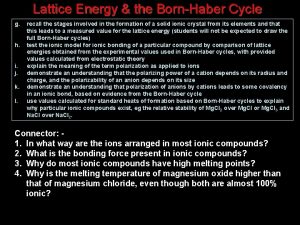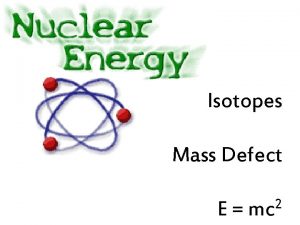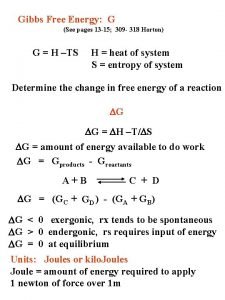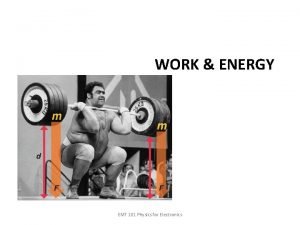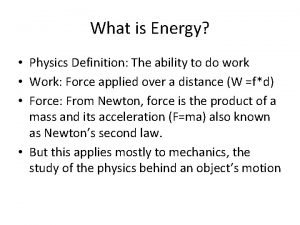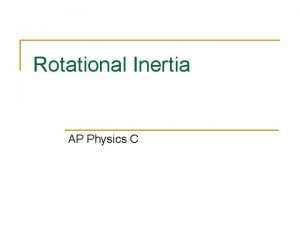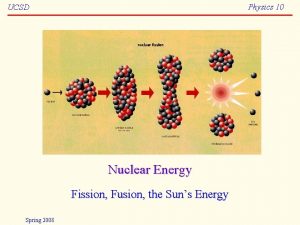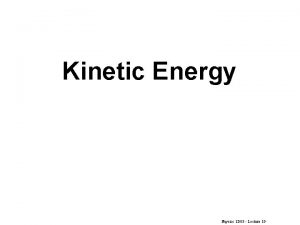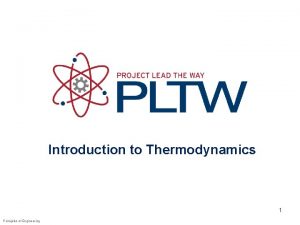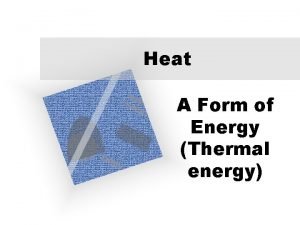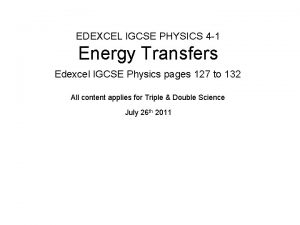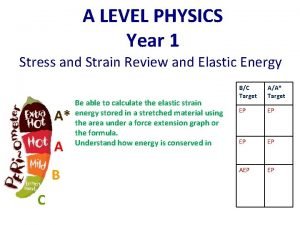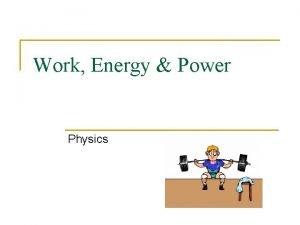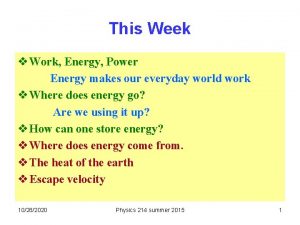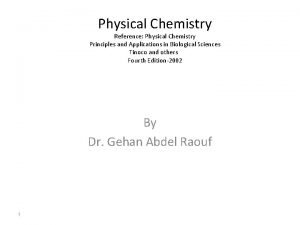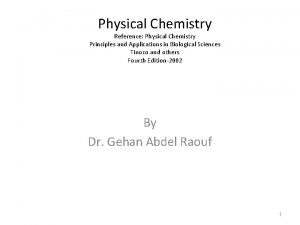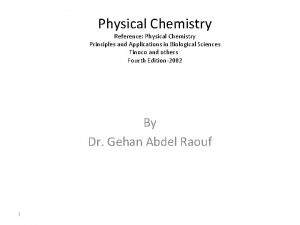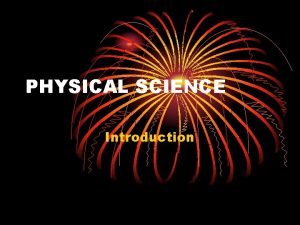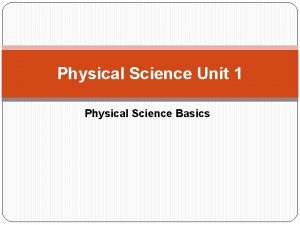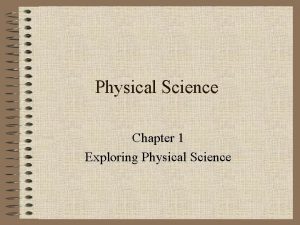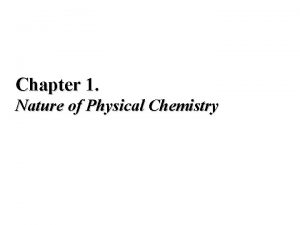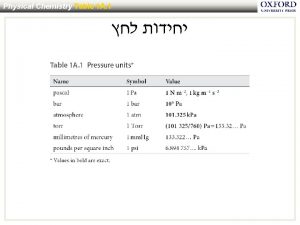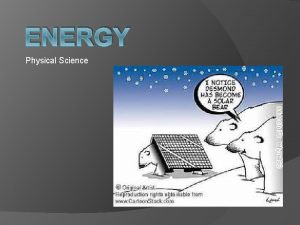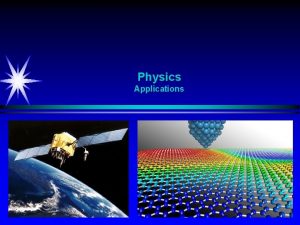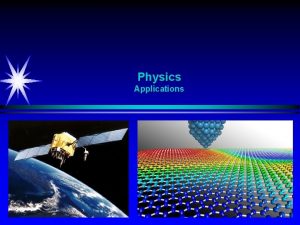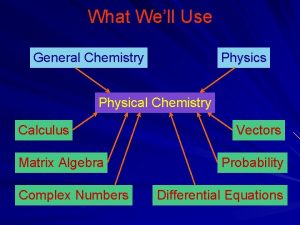Applications Of Energy Chemistry Physical Science Physics Applications
















































- Slides: 48

Applications Of Energy Chemistry Physical Science Physics Applications Of Energy Craig T. Riesen Energy Workshop II 1

Home Energy Audit Electric Energy & Electric Power Applications Of Energy Craig T. Riesen Energy Workshop II 2

Why Deal With The Issue Of Energy? • Our population continues to increase. • The use of energy by every individual continues to increase. • With more energy usage, pollution increases (air, water, noise, land). • Heavy reliance on foreign sources to supply our energy needs raises costs and causes international tensions. • Our international trade deficit increases, meaning we depend on other countries more. Applications Of Energy Craig T. Riesen Energy Workshop II 3

U. S. Population (Growth & Mortality) • One child is born every 8 seconds. • One person dies every 13 seconds. • One international migrant moves to the United states every 25 seconds • Net gain: one person every 11 seconds U. S. Census Bureau http: //www. census. gov/cgi-bin/popclock Applications Of Energy Craig T. Riesen Energy Workshop II 4

Electric Energy Consumed (including non-utility sources) in kilo. Watthours per Person in the US 8, 500 KWh person in 1975 14, 100 KWh person in 2005 US Dept. of Energy, US Census Applications Of Energy Craig T. Riesen Energy Workshop II 5

Electric Energy Consumption versus Population - USA ~4. 5 trillion k. Wh of energy ~310 million people in the US US Dept. of Energy, US Census Applications Of Energy Craig T. Riesen Energy Workshop II 6

The Near Future If the present trend between population and consumption person continues, the Department of Energy (DOE) projects that by 2020 we will need 1, 300 additional power plants to produce electric energy. Applications Of Energy Craig T. Riesen Energy Workshop II 7

Sources of U. S. Electric Energy Production in 1999 • • 52% from Coal 20 % from Nuclear 15% from Natural Gas 8% from Hydropower • Oil (3%) plays a minor role in electrical production Dept. of Energy Applications Of Energy Craig T. Riesen Energy Workshop II 8

How Do We Meet our Needs for Electric Power in the Future? • Reduce consumption • Smaller population • Use progressively less energy person as the population increases • Increase Storage – improve utilization of existing facilities • Interconnect utilities with transmission lines to share extra capacity • Utilize alternative sources and modify lifestyles to match the limitation of the alternative source. • Build more power plants: Gas, Coal, Oil, or Nuclear Applications Of Energy Craig T. Riesen Energy Workshop II 9

Storing Electric Energy • Large amounts of electricity are hard to store (e. g. batteries, “pumped storage”) • Utilities (electricity producing companies) must generate enough electricity to meet “peak” demands • Utilities want to run at reduced capacity most of the time to save costs Applications Of Energy Craig T. Riesen Energy Workshop II 10

One Example of Electrical Storage Buried Pipes for water flow Turbine/Generators for electric energy S. Lakeshore Drive Lake 2 miles long Ludington Pumped Storage Applications Of Energy Craig T. Riesen Energy Workshop II 11

Utilities Connect by Transmission Lines to Share Capacity Applications Of Energy Craig T. Riesen Energy Workshop II 12

Grids • Transmission lines allow sharing between Utilities • Failure of a major transmission line can cause whole grids to shut down as in the summer of 2003 Applications Of Energy Craig T. Riesen Energy Workshop II 13

Wind Power • Wind turbines in California • 1, 990 Wind Turbines • 1, 697 MW maximum output • 1. 5% of California’s Electric Energy • Wind turbines at Mackinaw City Michigan • 2 Wind turbines • 1. 8 MW maximum output Applications Of Energy Craig T. Riesen Energy Workshop II 14

Applications Of Energy Craig T. Riesen Energy Workshop II 15

Solar Currents Corner of Wagner and Scio Church in Ann Arbor Applications Of Energy Craig T. Riesen Energy Workshop II 16

Geothermal Energy • “Geo” = earth “thermal” = heat • Molten rock exists only 20 miles below us which can be piped to the surface for electrical energy production • The technology does not exist yet to drill that deep into the earth’s surface • The corrosive nature of the magma also makes it difficult to keep pipes clean Applications Of Energy Craig T. Riesen Energy Workshop II 17

Tapping Energy From Tides • Most areas have small tides • Tides are available twice a day • There is a large capital expense to build dams, turbines, generators, etc. • Tides vary throughout the year Applications Of Energy Craig T. Riesen Energy Workshop II 18

Biomass As An Energy Source • Comes from living organisms • Capture methane produced by the decomposition of waste (e. g. manure) • Produces CO 2 and CO • Limited amounts of biomass fuels are available Applications Of Energy Craig T. Riesen Energy Workshop II 19

Fuel Cells • Has the potential of producing no pollution • Based on the most abundant element in the universe (hydrogen) • The waste product is water vapor • Test vehicles (Buses, RVs, Cars) are running on hydrogen fuel cells presently … but are limited to ~90 miles Applications Of Energy Craig T. Riesen Energy Workshop II 20

Will Alternative Energy Sources Meet Our Energy Needs? • Alternative Sources like Hydropower, Wind & Solar Generators, Tides, etc. are presently producing less than 10% of our energy needs. • Many of these alternatives are in the experimental stage and will take years to perfect their usage … if even possible Applications Of Energy Craig T. Riesen Energy Workshop II 21

Decisions for the Future • Do you use more or less electricity than your parents did at your age? • Will your children use more electricity than you do when they are your age? • Will energy be available to meet our demands? Applications Of Energy Craig T. Riesen Energy Workshop II 22

• A way to save energy in their personal life • A luxury item they would be willing to live without should an energy crisis occur Applications Of Energy Craig T. Riesen Energy Workshop II 23

• Compile a list of items for your group • Have one person record the items on the white board … you do not have to repeat an item if another group already wrote that one down. Applications Of Energy Craig T. Riesen Energy Workshop II 24

Applications Of Energy Craig T. Riesen Energy Workshop II 25

How do we know how much electricity we use? And how much does it cost? We pay our power company (utility) to move the electrons back and forth from the power plant to our homes when we flip a switch Applications Of Energy Craig T. Riesen Energy Workshop II 26

Measuring Home Energy Use • The electricity we use is monitored by a meter • The rotating disk shown is connected to a series of dials • Each dial represents a digit, telling the meter reader how many kilowatts of electricity we have used Applications Of Energy Craig T. Riesen Rotating disk Energy Workshop II 27

Applications Of Energy Craig T. Riesen Energy Workshop II 28

Power The rate of energy production or usage - measured in Kilowatts, k. W Power = Work/time k. W = kilojoules/second Energy The Power used over a given period of time - measured in kilowatt-hours, k. Wh Energy = Power x Time k. Wh = k. W x hours Applications Of Energy Craig T. Riesen Energy Workshop II 29

Calculating Energy A 100 Watt light bulb left on for 1 hour k. Wh = k. W x hours 100 Watts = 0. 1 k. Wh = 0. 1 k. W x 1 hr would use 0. 10 k. Wh of energy Applications Of Energy Craig T. Riesen Energy Workshop II 30

Calculating Energy A 1500 Watt hair dryer running for 15 minutes k. Wh = k. W x hours 1500 Watts x 1 k. W/ 1000 Watts = 1. 5 k. W 15 minutes x 1 hour/60 minutes = 0. 25 hours k. Wh = 1. 5 k. W x 0. 25 hr would use 0. 375 k. Wh of energy Applications Of Energy Craig T. Riesen Energy Workshop II 31

So How Much Does Electricity Cost, Already? ! • It depends on who’s using the energy • It depends on what time of day and year the energy is being used Applications Of Energy Craig T. Riesen Energy Workshop II 32

Household Residents • Electrical energy consumption is determined by the average usage over a month’s time • American residents pay ~ 10 cents per kilowatt-hour for electrical energy Applications Of Energy Craig T. Riesen Energy Workshop II 33

Businesses, Large Schools, and Industry 1 k. Wh used at night costs ~ 3 cents 1 k. Wh can cost more than $40 if it is used during a time which adds to the annual maximum demand Applications Of Energy Craig T. Riesen Energy Workshop II 34

Businesses, Large Schools, and Industry Pay for Energy based on Demand • When would be a logical time for larger customers to use electricity? At Night • What time of year do you think corresponds to the annual maximum demand? The hottest part of Summer Air Conditioning The coldest part of Winter Heating Applications Of Energy Craig T. Riesen Energy Workshop II 35

Calculating The Cost Of Energy A 100 Watt light bulb left on for 1 hour at home • Residential Cost = $ 0. 10 / k. Wh • k. Wh = 0. 1 k. W x 1 hr = 0. 10 k. Wh x $ 0. 10 / k. Wh would cost $ 0. 01 Applications Of Energy Craig T. Riesen Energy Workshop II 36

Calculating The Cost Of Energy A 100 Watt light bulb left on for 1 hour at school in the coldest part of winter • Industrial Cost = $ 40 / k. Wh • k. Wh = 0. 1 k. W x 1 hr = 0. 10 k. Wh x $ 40 / k. Wh would cost $ 4. 00 Applications Of Energy Craig T. Riesen Energy Workshop II 37

Calculating The Cost Of Energy So what if you have 40 classrooms & offices with an average of ten 100 Watt lights? • $ 4. 00/light x 10 lights x 40 rooms That would cost $ 1600. 00 an hour! Applications Of Energy Craig T. Riesen Energy Workshop II 38

Energy Costs Versus Energy Conservation • Most people are concerned about the cost of energy. Therefore, they think about conserving evergy and finding alternative energy sources. • What is the greatest way to save energy and reduce energy costs? Knowing how much energy we use Knowing at what time that energy is consumed Applications Of Energy Craig T. Riesen Energy Workshop II 39

Applications Of Energy Craig T. Riesen Energy Workshop II 40

Applications Of Energy Craig T. Riesen Energy Workshop II 41

Your Electricity Usage • The Utility’s meter reader comes to your home and records the positions of the “kilowatt-hour dials” each month • The amount of energy used, measured in kilowatthours, is determined by subtracting the previous month’s reading from the latest reading • You can measure your electricity consumption each day by reading the meter yourself • And you will tonight for homework! Applications Of Energy Craig T. Riesen Energy Workshop II 42

Reading The Meter There are five “kilowatt-hour” dials so the reading will have 5 numbers Applications Of Energy Craig T. Riesen Energy Workshop II 43

Reading The Meter Dial 1 reads betwee n 7&8 So write down 7 as the LAST digit Applications Of Energy Craig T. Riesen Energy Workshop II 44

Reading The Meter Dial 2 reads between 5 & 6 Applications Of Energy Craig T. Riesen So write down 5 as the 2 nd to the LAST digit Energy Workshop II 45

Reading The Meter 90557 k. Wh Applications Of Energy Craig T. Riesen Energy Workshop II 46

Your Homework Assignment • Go home and read your electric meter • You will probably find the electric meter in the back of your home • For extra credit, take the reading again for at least three days in a row & record the readings. • Calculate the total k. Wh you used and show your work. • Calculate the cost of electrical usage for those 3 days using “residential” cost and show your work. Applications Of Energy Craig T. Riesen Energy Workshop II 47

Applications Of Energy Craig T. Riesen Energy Workshop II 48
 Brances of science
Brances of science Natural science vs physical science
Natural science vs physical science My favorite subject is english and math
My favorite subject is english and math Energy energy transfer and general energy analysis
Energy energy transfer and general energy analysis Energy energy transfer and general energy analysis
Energy energy transfer and general energy analysis Ib organic chemistry
Ib organic chemistry Inorganic chemistry vs organic chemistry
Inorganic chemistry vs organic chemistry Plastic scintillators: chemistry and applications
Plastic scintillators: chemistry and applications Applications of nuclear chemistry
Applications of nuclear chemistry Applications of nuclear chemistry
Applications of nuclear chemistry Physics and chemistry 4 eso
Physics and chemistry 4 eso Why does it happen
Why does it happen University physics with modern physics fifteenth edition
University physics with modern physics fifteenth edition Physics ia topic ideas
Physics ia topic ideas Rheochor formula
Rheochor formula Subatomic particles can usually pass undeflected
Subatomic particles can usually pass undeflected Physical chemistry crash course
Physical chemistry crash course Hittorfs law
Hittorfs law Physical chemistry problems
Physical chemistry problems Scope of physical chemistry
Scope of physical chemistry Chemical change
Chemical change The physical devices of a computer
The physical devices of a computer O level physics physical quantities units and measurement
O level physics physical quantities units and measurement Chapter 1 chapter assessment the central science
Chapter 1 chapter assessment the central science Gz science chemistry
Gz science chemistry Environmental chemistry science olympiad
Environmental chemistry science olympiad Light: science & applications
Light: science & applications Novel data science applications
Novel data science applications Science 10 physics review
Science 10 physics review Binding energy chemistry
Binding energy chemistry Potential and kinetic energy diagram
Potential and kinetic energy diagram Entropy ap chem
Entropy ap chem What is lattice energy in chemistry
What is lattice energy in chemistry E=mc2 cda
E=mc2 cda Gibbs energy
Gibbs energy Energy definition physics
Energy definition physics What is work physics
What is work physics Physics
Physics Kinetic angular energy
Kinetic angular energy 0kei0
0kei0 Nuclear energy in physics
Nuclear energy in physics Definition of kinetic energy in physics
Definition of kinetic energy in physics Thermal energy formula
Thermal energy formula Heat formula
Heat formula Igcse physics energy transfer questions
Igcse physics energy transfer questions Strain energy formula a level physics
Strain energy formula a level physics How many types of energy are there?
How many types of energy are there? Physics 03-01 work and the work-energy theorem
Physics 03-01 work and the work-energy theorem F= ma units
F= ma units










